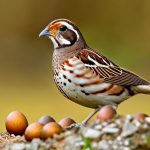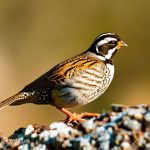Keeping quail in a colony setting can be a rewarding and enjoyable experience for poultry enthusiasts. Unlike traditional single-cage setups, a quail colony allows for a more natural and social environment for these small birds. In a colony, quail can exhibit their natural behaviors, such as dust bathing, foraging, and socializing, which can lead to healthier and happier birds. Additionally, keeping quail in a colony can be more space-efficient and cost-effective, as multiple birds can be housed together in a larger enclosure. This article will provide an in-depth guide to keeping quail in a colony, covering everything from choosing the right species to managing colony dynamics, feeding and nutrition, health and disease management, and breeding and reproduction.
Quail are known for their small size, gentle nature, and relatively low maintenance requirements, making them an ideal choice for poultry enthusiasts looking to keep a colony of birds. Whether you are a beginner or an experienced quail keeper, maintaining a quail colony can be a fulfilling hobby that provides fresh eggs, meat, or simply the joy of observing these fascinating birds. By understanding the specific needs of quail and providing them with a suitable environment, you can create a thriving colony that promotes the well-being of the birds while also providing you with the benefits of keeping quail.
Key Takeaways
- Keeping quail in a colony can be a rewarding and efficient way to raise these birds for eggs and meat.
- When choosing the right quail species for a colony, consider factors such as temperament, egg production, and adaptability to the local climate.
- Setting up the quail colony environment involves providing adequate space, shelter, and protection from predators.
- Managing quail colony dynamics requires monitoring for aggression, providing multiple feeding and watering stations, and ensuring a balanced male-to-female ratio.
- Feeding and nutrition for quail colony should include a balanced diet of commercial feed, fresh greens, and access to grit for digestion.
Choosing the Right Quail Species for a Colony
When it comes to keeping quail in a colony, choosing the right species is crucial for the success of your endeavor. There are several species of quail that are commonly kept in captivity, each with its own unique characteristics and requirements. The most popular species for colony keeping include the Coturnix quail (also known as Japanese quail), Bobwhite quail, and California quail. Coturnix quail are often preferred for their small size, prolific egg-laying abilities, and relatively calm demeanor, making them well-suited for colony living. Bobwhite quail, on the other hand, are known for their striking appearance and distinctive call, but they may require more space and can be more aggressive towards each other in a colony setting. California quail are another popular choice due to their attractive plumage and sociable nature, but they may have specific environmental requirements that need to be met.
When selecting the right quail species for your colony, it’s important to consider factors such as available space, climate, intended purpose (e.g., eggs, meat, ornamental), and personal preferences. Additionally, it’s essential to research the specific needs and behaviors of each species to ensure that you can provide them with an appropriate environment and meet their welfare requirements. By carefully considering these factors and choosing the right quail species for your colony, you can set the stage for a successful and enjoyable experience of keeping quail.
Setting Up the Quail Colony Environment
Creating a suitable environment for a quail colony is essential for the well-being and productivity of the birds. The first step in setting up the colony environment is to provide adequate housing that offers enough space for the quail to move around comfortably while also ensuring their safety and security. A spacious aviary or pen with secure fencing is ideal for housing a quail colony, as it allows the birds to exhibit natural behaviors such as dust bathing, foraging, and socializing. The enclosure should also provide protection from predators and environmental elements while allowing for good ventilation and natural light.
In addition to housing, the colony environment should include suitable bedding material such as straw or wood shavings to provide a comfortable and clean substrate for the quail. Access to fresh water is essential, so providing multiple water sources throughout the enclosure is recommended to ensure all birds have access. Furthermore, incorporating natural elements such as perches, hiding spots, and vegetation can enrich the environment and provide stimulation for the quail. It’s important to regularly clean and maintain the colony environment to prevent the buildup of waste and minimize the risk of disease. By creating a well-designed and enriching environment for your quail colony, you can promote their physical and psychological well-being while also enhancing your enjoyment of keeping these birds.
Managing Quail Colony Dynamics
Managing the dynamics of a quail colony is crucial for maintaining harmony among the birds and preventing aggression or stress-related behaviors. Quail are social animals that have a complex hierarchy within their groups, so understanding their social dynamics is essential for successful colony management. When introducing new birds to an existing colony or integrating different age groups, it’s important to do so gradually to minimize potential conflicts. Providing multiple feeding and watering stations can help reduce competition and aggression among the birds, as well as ensuring that there are enough resources for all members of the colony.
Observing the behavior of the quail regularly can help identify any signs of aggression or stress, allowing for prompt intervention if necessary. In some cases, separating aggressive or injured birds from the colony may be necessary to prevent further harm. Additionally, providing adequate space and environmental enrichment can help reduce stress and boredom among the birds, leading to a more harmonious colony dynamic. By understanding and managing the social dynamics of your quail colony, you can create a peaceful and cohesive living environment for your birds while minimizing potential conflicts.
Feeding and Nutrition for Quail Colony
Proper feeding and nutrition are essential for maintaining the health and productivity of a quail colony. Quail have specific dietary requirements that need to be met to ensure optimal growth, egg production, and overall well-being. A balanced diet for quail typically consists of high-quality commercial feed specifically formulated for game birds or poultry. Additionally, providing access to grit or insoluble materials is important for aiding in digestion and supporting overall gut health in quail.
In addition to commercial feed, offering supplemental treats such as fresh fruits, vegetables, mealworms, or greens can provide enrichment and variety in the diet of the quail. It’s important to monitor the body condition of the birds regularly and adjust their feeding regimen accordingly to prevent issues such as obesity or malnutrition. Providing access to clean water at all times is crucial for quail health, especially during hot weather or periods of high egg production. By ensuring that your quail colony receives a balanced diet that meets their nutritional needs, you can promote their overall health and productivity while enjoying the benefits of keeping these delightful birds.
Health and Disease Management in Quail Colony

Maintaining the health of a quail colony is essential for preventing disease outbreaks and ensuring the well-being of the birds. Regular health checks and observation of the birds can help identify any signs of illness or injury early on, allowing for prompt intervention if necessary. Providing a clean and well-maintained environment is crucial for preventing the spread of diseases among the quail colony. Regular cleaning of the enclosure, proper waste management, and disinfection of equipment can help minimize the risk of disease transmission.
In addition to environmental management, practicing good biosecurity measures can further reduce the risk of introducing pathogens into the quail colony. This includes limiting contact with wild birds or other poultry species, quarantining new arrivals before introducing them to the colony, and practicing good hygiene when handling the birds or their equipment. It’s also important to establish a relationship with a veterinarian experienced in avian medicine who can provide guidance on disease prevention and treatment if needed. By implementing proactive health management practices and maintaining good biosecurity measures, you can help ensure the long-term health and well-being of your quail colony.
Breeding and Reproduction in Quail Colony
Breeding and reproduction are integral aspects of maintaining a quail colony for those interested in producing offspring for eggs or meat. Quail are prolific breeders that reach sexual maturity at an early age, making them relatively easy to breed in captivity. When setting up a breeding program within a quail colony, it’s important to provide suitable nesting areas where hens can lay their eggs in privacy. Additionally, ensuring that there is an appropriate sex ratio within the colony can help promote successful breeding behavior without causing excessive stress or aggression among the birds.
Once eggs are laid, they should be collected daily to prevent damage or contamination and placed in an incubator if hatching is desired. Proper incubation conditions such as temperature, humidity, and turning are essential for successful hatching of quail eggs. After hatching, providing appropriate brooding conditions for the chicks is crucial for their survival and development. By understanding the breeding behavior of quail and providing suitable conditions for reproduction within the colony, you can successfully produce offspring while maintaining the overall health and welfare of your birds.
In conclusion, keeping quail in a colony setting offers numerous benefits for both poultry enthusiasts and the birds themselves. By choosing the right species, creating a suitable environment, managing colony dynamics, providing proper nutrition, maintaining health and disease management practices, and understanding breeding behavior, you can create a thriving and enjoyable quail colony experience. Whether you are interested in fresh eggs, meat production, or simply observing these fascinating birds in a natural social setting, maintaining a quail colony can be a fulfilling hobby that provides endless rewards. With proper care and attention to their specific needs, keeping a quail colony can be an enriching experience that fosters a deeper appreciation for these charming avian companions.
If you’re interested in keeping quail in a colony, you may also want to consider the best location for your chicken coop. Poultry Wizard has a helpful article on where to put your chicken coop to ensure the health and happiness of your flock. Proper placement can make a significant difference in the well-being of your birds and the success of your poultry operation.
FAQs
What is a quail colony?
A quail colony refers to a group of quail birds that are kept together in a shared living space, such as a coop or aviary. This is in contrast to keeping quail in individual cages.
How many quail can be kept in a colony?
The number of quail that can be kept in a colony depends on the size of the living space and the breed of quail. Generally, it is recommended to provide at least 1 square foot of space per quail to ensure they have enough room to move around and establish a pecking order.
What are the benefits of keeping quail in a colony?
Keeping quail in a colony allows them to exhibit natural social behaviors, such as establishing a pecking order and forming social bonds. It also reduces the need for individual housing and can make it easier to manage and care for the birds.
What are the challenges of keeping quail in a colony?
One challenge of keeping quail in a colony is the potential for aggression and pecking within the group. It is important to monitor the birds closely and provide enough space, hiding spots, and resources to minimize conflicts.
What should be considered when setting up a quail colony?
When setting up a quail colony, factors such as space, shelter, food and water access, and social dynamics should be carefully considered. Providing ample space, multiple feeding and watering stations, and places for the quail to hide and seek refuge can help promote a harmonious colony environment.
Meet Walter, the feathered-friend fanatic of Florida! Nestled in the sunshine state, Walter struts through life with his feathered companions, clucking his way to happiness. With a coop that’s fancier than a five-star hotel, he’s the Don Juan of the chicken world. When he’s not teaching his hens to do the cha-cha, you’ll find him in a heated debate with his prized rooster, Sir Clucks-a-Lot. Walter’s poultry passion is no yolk; he’s the sunny-side-up guy you never knew you needed in your flock of friends!







